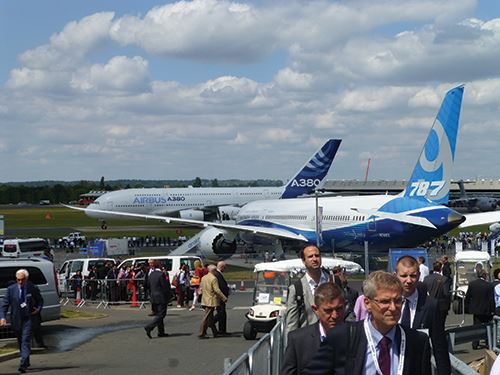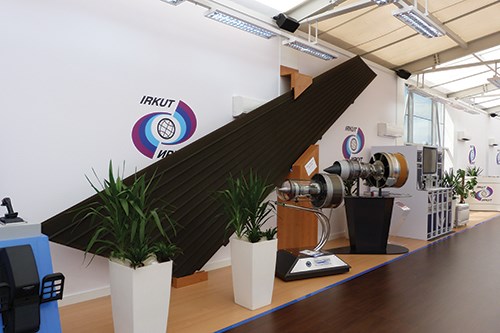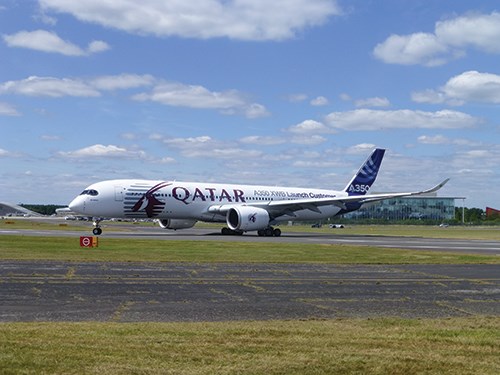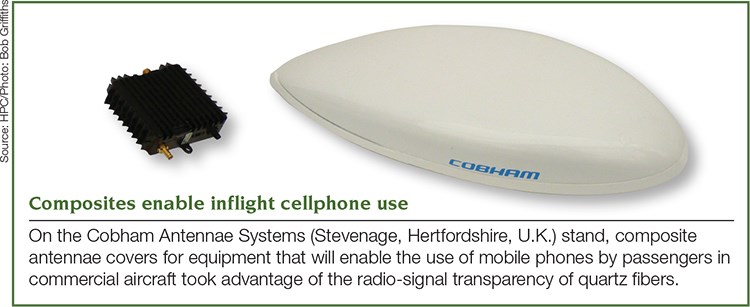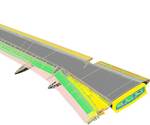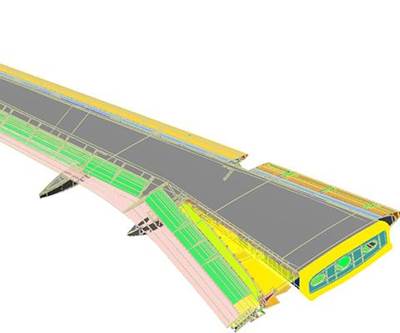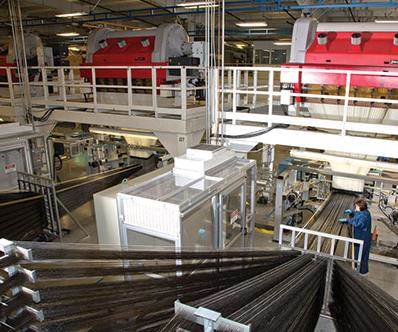Farnborough 2014 Airshow Report
No longer a novelty at aerospace trade events, composites nevertheless faced competition from conventional materials at this year’s event.
At the Farnborough International Airshow and others like it, the display of composite aerostructures has almost become normal in recent years, and they are a major feature in many new aircraft programs. However, this year, composites were less conspicuous than they have been at previous Farnborough shows.
Held every other year (alternating with the Paris Air Show in Le Bourget, France), Farnborough’s 2014 edition, held July 14-20, was the stage for Airbus (Toulouse, France) and The Boeing Co. (Chicago, Ill.) announcements, respectively, of the new A330neo and 777X commercial aircraft.
Metal strikes back
Actually, significant revisions of popular existing models, both will proceed with metal fuselages. These events underscored the need for composite structures to earn their way onto aerospace programs, not only in terms of cost but also with an eye to the potential risk to program time scales.
That said, Boeing’s 777X will have all-new and longer wings, made from composite materials, using 787 technology. Boeing judged that the dry fiber/infusion technology it developed for the movables of the 787 wing was not yet ready for such a large structure as the 777X wingbox.
The wing length was increased substantially to optimize the aircraft’s aerodynamic performance. To enable the aircraft to operate from existing jet ways and aircraft berths at airports, many of which are too narrow to accommodate the greater wingspan, the outer portion of each wing will fold, rather like that of a carrier-based fighter jet.
The 777X fuselage will be metal and remain largely unchanged. The big surpise was that it will feature bigger windows (15 percent larger than those fielded by competitors) and enhanced cabin pressure and humidity. Previously, Boeing had claimed that these features, which are judged to be a big success on the 787, were made possible by the use of composite materials in that aircraft’s fuselage.
The new announcement from the Airbus camp represents some strategic marketing decisions. In terms of size, and therefore passenger capacity, the new A350 XWB sits somewhere between the Boeing 787 and the larger 777X. Therefore, the smaller A330 has continued to sell well despite being very much a “previous generation” aircraft. Tom Leahy, COO of Airbus, announced that the company has finally decided to launch an A330neo, of which the company expects to sell 1,000 aircraft. The revised aircraft’s most notable feature is a new Rolls-Royce (London, U.K.) Trent 7000 engine with a 112-inch/284-cm fan. The Trent 7000 builds on the record of the Trent 1000 used on the Boeing 787. Fully 95 percent of the A330neo’s airframe will remain unaltered. The only new composite features reported were the wing extensions and Sharklet winglets. There will be some changes to the metal wingbox to save weight to balance the heavier engines and longer wings. The emphasis on this program is clearly to engage in a rapidly developed, low-risk project that will yield a passenger jet with performance that will rival to that of the 787.
Discussions with Rolls-Royce’s Tim Boddy revealed that the new Trent 7000 engine for the A330neo will incorporate conventional titanium fan blades. According to Boddy, composite blades and fan cases, which Rolls-Royce is codeveloping with GKN Aerospace (Redditch, Worcestershire, U.K.), demonstrate superiority over conventional materials only in larger engines with higher bypass ratios. Rolls-Royce is reportedly building a demonstrator to prove the concepts for the composite fan blades, spacers and fan cases under development by CTAL, a Roll-Royce/GKN joint venture based on the Isle of Wight, U.K.
The take-away from these Farnborough developments is clear: Composites have to work harder to justify their use because of higher nonrecurring costs (NRC) and perceived technical and manufacturing risks.
Infused single-aisle wing
Elsewhere, the Moscow, Russia-based airframer Irkut is at work on its MS-21 aircraft. Fitted with 180 seats it will compete with the Airbus A320 and the Boeing 737, but will offer a wider cabin. Its advantage will be a composite wing box and Pratt & Whitney’s (East Hartford, Conn.) Geared Turbofan engines. Its composite wingbox will be fabricated by Ulyanovsk, Russia-based AeroComposit, which, like Irkut, is a subsidiary of the United Aircraft Corp (UAC).
MC-21 program deputy director Sergey Chernata explained that the wingskin on display at the show had been infused and then cured in an oven rather than an autoclave, using materials supplied by Hexcel (Stamford, Conn.). The part’s cosmetically beautiful skin incorporated integral “T” stiffeners, was 7.5m/24 ft long but weighed only 50 kg/110 lb (see “Learn More”).
Outstanding stands
On the Cytec stand, that company’s VP of technology, Carmelo Lo Faro, was asked about the merits of Cytec’s dry-fiber unidirectional (UD) tape materials. He emphasized, first, that Cytec offered a wide range of products from which the customer could choose an optimum solution for their application. Dry UD tapes, he noted, meet the needs of some but not all customers. Benefits that help make the case for dry UD tape include the potential for weight optimization through the use of tailored ply drop-offs and that fact that precision automated layup systems are available.
Representing GKN, two young engineers — Ben Davies, a manufacturing engineer and Sophie Wendes, a research engineer — reviewed recently developed composites technologies. These included the following:
- The “STeM” project, undertaken jointly with Bombardier (Montreal, Quebec, Canada), Spirit AeroSystems (Wichita, Kan.) and GE Aviation (Evendale, Ohio), which demonstrated a winglet with one skin integrated with a “waffle” stiffening structure. In-process inspection was undertaken using thermography. The much-reduced parts count foreshortened assembly time; assembly time was further reduced, by 23 percent, by the use of a robot to drill the fastening holes.
- A one-piece fan case liner with an acoustic treatment around its entire circumference.
- A composite wing leading edge slat, on display at the show, featured electro-thermal ice protection and an erosion shield. Video footage of an impact test with a 4-lb/1.8-kg bird at 350 knots was shown. This technology is now supplied to Boeing for its 787.
- Also on display was an aileron supplied to Bombardier for its CSeries aircraft. It was produced by means of a one-shot molding technique developed at GKN’s factory in Munich, Germany, and now used to supply parts from its facility on the Isle of Wight.
- Likely the shiniest composite part on display anywhere at the Farnborough airshow was GKN’s laminar flow, wing leading edge demonstrator part. GKN made the part in conjunction with The National Composites Centre, near Bristol, U.K.
Mike Blair, VP and GM of the Aerostructures Div. of Exelis (McLean, Va.), reviewed the wide range of composite structures and components made by the company. Although some were made using technology developed in-house developed most reflected the company’s current policy of being a “fast follower.”
Traditional products based on their filament winding technology included JASSM wings and fuselages, still produced at a rate of 16 sets a month, and water and waste tanks for almost all the world’s civil aircraft and now being joined by exciting new products. These include
- more than 240 parts for the F-35, many in carbon fiber/BMI
- fuselage frames on the Boeing 787-9 and -10, for sections 41 and 43.
- variable bleed valves and ducts for GE’s engines for the Boeing 787 and 747.
- plugs for the hydraulic fracking industry.
- sponsons, pylons and horizontal stabilizers for Sikorsky’s CH-53K helicopter.
- an all-composite, filament wound strut, using an innovative tooling system that enables rapid changes to be made in development. The technology has been licensed from Bodair SA (Belgium) but no applications can be mentioned at present.
To prepare for this work, the Exelis facility has been expanded from 130,000 ft2 to 250,000 ft2, and will increase to 390,000 ft2 by the end of the year.
At the Elbit Systems – Cyclone Ltd.(Karmiel, Israel) display, CEO Eitan Cohen proudly reported that the company had just won contracts for 16 composite parts on the F-35 Lightning II jet fighter. Other than saying that they were structural assemblies and fairings, Cyclone was unable to say which parts they were going to make for Northrop Grumman, but did confirm that a dedicated factory was under construction and will be equipped with new equipment, including machine tools, autoclaves and inspection equipment.
On display were two integrated, one-piece structures, an aileron and a winglet, made by resin transfer molding (RTM). The latter weighed 30 percent less than a conventionally assembled composite part.
Albany Engineered Composites Inc. (AEC, Rochester, N.Y.) continues to produce parts in conjunction with its main European customer Safran. An AEC/Safran joint venture is building new production facilities on both sides of the Atlantic, one in Rochester and the other in Commercy, France. Both will make parts for CFM International’s (Melun, France, and Cincinnati, Ohio) LEAP engine, including the main fan blades.
AEC also displayed its trademarked Ceramic Truss Core (CTC) sandwich panels. These much newer materials were intended to operate at 400°C to 1,200°C (752°F to 2,192°F). This product is an outgrowth of the “X” Core carbon fiber product developed by Aztex, a company acquired by AEC nearly a decade ago. CTC panels have application in areas where hot exhaust gasses wash over structures, such as engine exhaust cones.
One rapidly expanding niche composite application was on display on in both the Ten Cate Advanced Composites (Nijverdal, The Netherlands) and the Cobham Antennae Systems (Stevenage, Hertfordshire, U.K.) stands: Antennae covers for equipment that will enable the use of mobile phones by passengers in commercial aircraft (see photo, p. XX). Whatever air travelers might think of loosing the one peaceful period in a business trip, all the major airlines are preparing to offer inflight use of cell phones. This requires the use of very high frequency signals (Ka and Ku band), and these must be transmitted at low loss through the covers that protect the antennae. For these covers, Cobham uses cyanate ester resin with quartz fibers supplied by TenCate Advanced Composites.
U.S. export control meeting
One of the most interesting meetings at Farnborough was hosted by the AIA (Aerospace Industries Assn.) and covered U.S. Export Control Reform. The panel was moderated by Marion C. Blakey, AIA president. The panel consisted of Kevin Wolf, assistant secretary of Commerce for Export Administration, U.S. Department of Commerce; Beth McCormick, director, Defense Technology Security Administration, Department of Defense; and Ken Handelman, Deputy Assistant Secretary for Defense Trade Controls, Bureau of Political and Military Affairs, Department of State.
The process of gaining permission to export controlled products and materials was in the process of being simplified and made much more transparent. Under the new regime, the ultimate goal of the reform effort is the creation of four “singles”:
- A single Licensing Agency
- A single Export Control List
- A single Enforcement Coordination Agency
- A single information technology system
The three officials reported on the status of each of the efforts.
Enforcement: In November 2010, President Obama directed the creation of the Export Enforcement Coordination Center, which formally opened in 2012. The center serves as the single enforcement coordination agency and allows all U.S. agencies with export enforcement responsibilities to work together, along with intelligence agencies, to coordinate enforcement actions.
Information Technology: The U.S. agencies involved in reviewing license applications are working to migrate to a single I.T. system. Currently, the Departments of Defense and State are using the single I.T. system, and the Department of Commerce is expected to follow suit later this year. The single I.T. system only applies to agency referrals; it does not affect the portals by which parties submit their license applications to the respective agencies.
Single Licensing Agency and List: To create a single licensing agency and a single export control list, legislation will be required. The Departments of Commerce, Defense, and State are working to review the current control lists, which will aid in the eventual creation of a single list. As part of the list review, there will be four “principles”:
- Protecting the Crown Jewels – those items providing a critical military or intelligence capability
- Providing more flexible controls for the transfer of less-sensitive munitions items to allies and partners
- Meeting international commitments and obligations to the multilateral export control regimes; and
- Preventing exports to countries and entities “of concern”
The primary list under review is the U.S. Munitions List of the International Traffic in Arms Regulations (ITAR), which are administered by the Department of State. Items remaining on the USML will be enumerated as specifically as possible using performance capability or technical parameters to help exporters determine if their item is listed on the USML. To accomplish this task, one of the biggest changes will entail eliminating the majority of “catch-all” controls on the USML, which primarily consisted of parts and components specifically designed for a military item. The majority of these items will move to the Commerce Control List (CCL) of the Export Administration Regulations, which are administered by the Department of Commerce. Under the CCL, such items will be able to take advantage of more nuanced controls, which allow for exceptions to the requirements for license applications. One such exception, License Exception Strategic Trade Authorization, will allow for more flexible trade in less-sensitive military items. By tailoring controls, the reform effort will allow for greater interoperability among the U.S., NATO countries and other allied countries.
The review and rewrite of the USML are at an advanced stage. Fifteen USML categories are currently complete. Twelve of the 15 are currently effective, and two more will become effective by the end of the year. Three more categories are currently under review, and three are on hold. The agencies hope to publish, by the end of the year, proposed rules for the three categories currently under review.
The conclusion that can be drawn from the airshow is that the aerospace industry’s approach to composites has matured. Composite materials are no longer the “must have” marketing feature that all new programs must adopt regardless of risk and cost. From now on, the composites industry will have to demonstrate that each application can be delivered on time with little or no risk.
Read Next
Resin-infused MS-21 wings and wingbox
Moscow-based aeromanufacturer uses out-of-autoclave composites in attempt to leapfrog Airbus and Boeing with wider, lighter, more efficient single-aisle airliner.
Read MoreAlbany Engineered Composites: Weaving the Future in 3-D
This 3-D weaver turned composite component supplier pursues a future in 3-D structures through continuous technology development.
Read MorePlant tour: Daher Shap’in TechCenter and composites production plant, Saint-Aignan-de-Grandlieu, France
Co-located R&D and production advance OOA thermosets, thermoplastics, welding, recycling and digital technologies for faster processing and certification of lighter, more sustainable composites.
Read More
